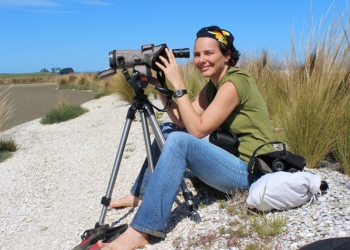
May 3, 2024—CHICAGO—The American Ornithological Society (AOS) is pleased to announce Judit K. Szabo, Ph.D., as the incoming editor-in-chief for its top-ranked journal, Ornithological Applications. Beginning on May 1, 2024, Dr. Szabo will work in partnership with the journal’s current editor-in-chief, Catherine Lindell, Ph.D., until June 30, 2024, and will take on full responsibility as editor-in-chief beginning on July 1, 2024. “With her international interest and network, conservation experience, and thoughtful approach to editorial teamwork, Judit brings a great skill set to Ornithological Applications. I look forward to working with her,” Dr. Lindell says.
Dr. Szabo, Adjunct Research Fellow at Charles Darwin University, is a conservation biologist and ornithologist who previously served as an associate editor of Bird Conservation International for 11 years; as Editor-in-Chief of Avian Conservation and Ecology for three years; as Science Editor of Stilt for four years; and as a regular reviewer of many top ornithological and conservation biology journals for decades. “This is a humbling opportunity to carry the legacy of Ornithological Applications and make science available to inform on-the-ground conservation and management of birds,” Szabo says of her new appointment. “I am most excited about sharing my enthusiasm, professionalism, and international experience with readers of Ornithological Applications,” she adds. She joins a strong AOS editorial team that includes Ornithology editor-in-chief Christina P. Riehl, Ph.D., and a cadre of senior and associate editors from both AOS journals.
Dr. Szabo received a master’s degree in ecology from the University of Szeged, Hungary, in 1999, and her doctorate in ecotoxicology from Texas Tech University in 2006, studying the effects of pesticides on Australian birds. She was a postdoctoral fellow at the University of Wollongong and the University of Queensland, and a research fellow at Charles Darwin University in Australia, where she is currently Adjunct Research Fellow.
During her academic career, Dr. Szabo has studied optimal monitoring of birds, including threatened species. She contributed to the Red List assessment to determine the threat of extinction of all Australian bird species and subspecies and co-authored the Action Plan for Australian Birds 2010. She worked outside academia for the conservation of migratory waterbirds and their habitats in the East Asian–Australasian Flyway, as well as on policy capacity building of non-governmental organizations in Africa and Asia. Since 2018, she has been working in Brazil. Her current interests include analyzing volunteer-collected datasets to unravel patterns and trends in bird distributions. Since 2014, she has been the Chair of the International Ornithological Union Research Coordination Committee on Bird Marking and also led several field courses to train people in bird banding around the world. She has banded and surveyed birds around the world, including Australia, Brazil, Costa Rica, Israel, Hungary, South Korea, Spain, Venezuela, and the U.S. She also has a keen interest in academic editing and translating.
Dr. Szabo has loved birds and other animals since childhood; her earliest memories are of rescuing mole crickets from her mother’s garden. Her birdwatching journey began at the age of 13, when she began going out on birdwatching and bird banding weekend trips with a local group. “Since my earliest memories as a child, I have always loved all kinds of birds,” she shares. “My current favorites are a couple of Bananaquits and four or five regular Swallow-tailed Hummingbirds who—for years—are trying to figure out who is the boss of the hibiscus plants flowering in my window.” When asked how she hopes to inspire future generations of ornithologists, she turned the question around, stating, “It is the enthusiasm of the young ornithologists I meet that gives me inspiration!”
Dr. Szabo’s enthusiasm for birds is clearly contagious. When she first met her husband, she says, “he knew about five different bird species. Now he can tell overflying parrots by the call and we have to stop and adore every Chalk-browed Mockingbird we see (his favorite bird).”
Follow Dr. Szabo’s research through her ORCID-ID.
About the Journal
Ornithological Applications is an international, scientific journal of the American Ornithological Society (the other is Ornithology). The journal publishes original research, syntheses, and assessments from all parts of the globe focusing on the application of scientific theory, ornithological knowledge, and methods to the conservation and management of birds, and to policy.
First published in 1899 by the Cooper Ornithological Society as The Bulletin of the Cooper Ornithological Club, the journal was renamed in 1900 to The Condor: A Magazine of Western Ornithology, and later still (1947) to The Condor: Journal of the Cooper Ornithological Club. In 2021, it became Ornithological Applications, currently one of two of the world’s foremost ornithological journals published by the American Ornithological Society.


